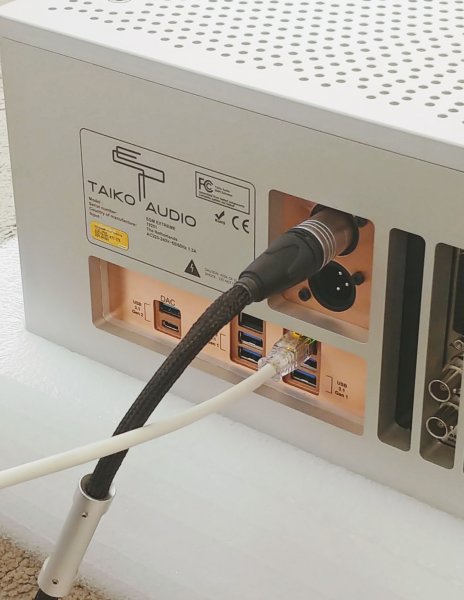The question is what type of sound people prefer - order or chaos?
That made me smile. It is really a lot closer then you would expect though.
The question is what type of sound people prefer - order or chaos?
IMHO it is very hard to discuss USB versus AES/EBU. I immediately see an asynchronous versus a synchronous interface. The classical drawback of AES/EBU (clock regeneration) does not exist in professional or top systems that use a master clock, apparently AES/EBU is more predictable and easier to debate, particularly as bandwidth is more limited. Asynchronous processes are apparently much more chaotic. The question is what type of sound people prefer - order or chaos?
Would adding a usb or network pcie card which has audiophile upgrades of capacitors and femto clocks allow further performance increases over the built in ports on the main board of the Extreme?
We have not come across one that does so far.
Emile is "Da Man"This is a good news.
I think Taiko discovered the way to avoid clocks and additional expansion cards.
It is interesting how they did it but it sounds like it works better than adding tjis cards or exchanging clocks.
Also this approche simplyfies the amount of hardwere and softwere .
I listened to the Extreme driving a Totaldac Direct+Relclocker on Fri.There are really only 2 options:
-Lynx AES16e
-RME HDSPe AES
We use the RME with the Extreme. We modify it to be able to use high end AES/EBU cables. We can also fit transformers to convert AES/EBU to SPDIF. The RME is more transparent / revealing. The Lynx is a bit more veiled which can be good for electrically noisy servers. That is why you may find comments online about the Lynx sounding "warmer" or "fuller" when used in digital audio workstations.
As for USB versus AES/EBU:
There is a functional difference, single channel AES/EBU is limited to 24/192 sample rates. If the DAC supports it you can split channels into dual or quad wire AES/EBU. DCS supports this, it allows you to play 24/384 files by splitting it into 2 x 24/192. You will obviously run into issues with DSD playback.
USB is only limited in sample rate and amount of channels by what the DAC USB receiver supports.
Sound quality between the two is generally competitive. Which one performs better depends on the implementation of the DAC interface, some DACs have superior AES/EBU interfaces, others have superior USB interfaces, and some are just on par. The Totaldac falls into the "on par" category, your preference may come down to your AES/EBU versus USB cable quality.

listened to the Extreme driving a Totaldac Direct+Relclocker on Fri.
The aes/ebu digital cable was only a mid grade Westminster Lab.
The sonic result was definitely not bad!
Emile.
When I was experimenting with servers few years ago the limiting factor was the supply.
In short the more watts the better.
Currently extreme has a 400w supply.
Do you think it is possible to double that for custom version of the extreme ?
I listened to the Extreme driving a Totaldac Direct+Relclocker on Fri.
The aes/ebu digital cable was only a mid grade Westminster Lab.
The sonic result was definitely not bad!
View attachment 54904
I think other than MSB dac users who can install a MSB ProUSB optical usb device, owners of other dac when buying Extreme should seriously consider installing a spdif digital output option to enhance flexibility.

We have not come across one that does so far.
Dear Emile
I think many of us considering the extreme purchese would love to see the test results
Of the 3 ways of getting from Exteteme to totalDac:
1. Getting via USB with intona cables and intona 3.0 that is considered best.
2. Getting via AES with the best possible cable ( Absolue Creation tim ref signature)
3. Getting via Spidf with best BNC cable available ( same as above).
Could you please experiment a little in that area ?
I think if one way is much better than we can consider avoiding unnecessary costs that plays a significant role in some pockets .
Your kind opinion in this area will be priceless
Hi Emile,
For fibre cable itself is it better to choose a Class B grade with lower insertion loss and does the polishing, APC/UPC and jacket material PVC/LSZH matter if using the previously mentioned Startech products.
Just thinking to implement a fibre optic link to replace my WiFi extender and it’s there for any potential future upgrade path.
Cheers
Many of my EMMLabs owner friends use this gel.I’m just going to throw this out there and run before rotten fruit gets pelted in my direction........
www.auralsymphonics.com/iogel%202013.html
I previously used this on the dual ST glass cables of an Audio Synthesis Transcend / Dax Discrete and found the sound more focused, grainfree and solid. Perhaps there is an industrial equivalent at a much cheaper price?!?
Many of my EMMLabs owner friends use this gel.

am currently running tests with 10Gb and even 25Gb fiber and copper networking. I will share when I have conclusive results.
I am currently running tests with 10Gb and even 25Gb fiber and copper networking. I will share when I have conclusive results.
| Steve Williams Site Founder | Site Owner | Administrator | Ron Resnick Site Owner | Administrator | Julian (The Fixer) Website Build | Marketing Managersing |


